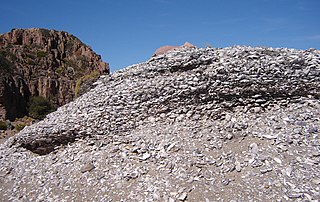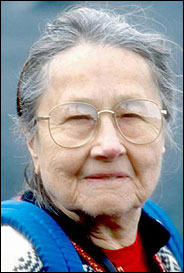
A midden is an old dump for domestic waste which may consist of animal bone, human excrement, botanical material, mollusc shells, potsherds, lithics, and other artifacts and ecofacts associated with past human occupation.
Roderick Sprague III was an American anthropologist, ethnohistorian and historical archaeologist, and the Emeritus Director of the Laboratory of Anthropology at the University of Idaho in Moscow, where he taught for thirty years. He had extensive experience in environmental impact research, trade beads, aboriginal burial customs, and the Columbia Basin area. Sprague was president of the Society of Bead Researchers from 2004-2007.

Environmental archaeology is a sub-field of archaeology which emerged in 1970s and is the science of reconstructing the relationships between past societies and the environments they lived in. The field represents an archaeological-palaeoecological approach to studying the palaeoenvironment through the methods of human palaeoecology and other geosciences. Reconstructing past environments and past peoples' relationships and interactions with the landscapes they inhabited provide archaeologists with insights into the origins and evolution of anthropogenic environments and human systems. This includes subjects such as including prehistoric lifestyle adaptations to change and economic practices.
Roald Hilding Fryxell was an American educator, geologist and archaeologist. He was a Professor of Anthropology at Washington State University (WSU) and pioneer in the interdisciplinary field of geoarchaeology, with a career that involved work on monumental projects in North America and even outer space.
Patrick Vinton Kirch is an American archaeologist and Professor Emeritus of Integrative Biology and the Class of 1954 Professor of Anthropology at the University of California, Berkeley. He is also the former Curator of Oceanic Archaeology in the Phoebe A. Hearst Museum of Anthropology, and director of that museum from 1999 to 2002. Currently, he is professor in the department of anthropology at the University of Hawai'i Manoa, and a member of the board of directors of the Bishop Museum.
Joyce Marcus is a Latin American archaeologist and professor in the Department of Anthropology, College of Literature, Science, and the Arts at the University of Michigan, Ann Arbor. She also holds the position of Curator of Latin American Archaeology, University of Michigan Museum of Anthropological Archaeology. Marcus has published extensively in the field of Latin American archaeological research. Her focus has been primarily on the Zapotec, Maya, and coastal Andean civilizations of Central and South America. Much of her fieldwork has been concentrated in the Valley of Oaxaca, Mexico. She is known for her "Dynamic model", four-tiered hierarchy, and her use of interdisciplinary study.

Gatecliff Rockshelter (26NY301) is a major archaeological site in the Great Basin area of the western United States that provides remarkable stratigraphy; it has been called the "deepest archaeological rock shelter in the Americas". Located in Mill Canyon of the Toquima Range in the Monitor Valley of central Nevada, Gatecliff Rockshelter has an elevation of 7,750 feet (2,360 m). David Hurst Thomas discovered Gatecliff Rockshelter in 1970 and began excavations in 1971. Full scale excavations occurred at Gatecliff Rockshelter for about seven field seasons in which nearly 33 feet (10 m) of sediments were exposed for a well-defined stratigraphic sequence. The well-preserved artifacts and undisturbed sediments at Gatecliff Rockshelter provides data and information have been applied to a range of research topics. Based on the analysis of the artifacts at Gatecliff Rockshelter, it can be determined that it was most likely a short-term field camp throughout prehistory. The latest evidence for human usage at Gatecliff occurs between ca. 5500 B.P. to 1250 B.P.
Judith Ann Bense is an American academic, Florida historical archaeologist, and a former president of the University of West Florida. She is also the chairwoman of the Florida Historical Commission at the University of West Florida, she served as a faculty member and department chair in the anthropology program, which she started at the school. In 2008, she started her 7-year term as president of the university. Prior to this, she was the executive director of anthropology and archaeology at UWF. During her career, she was fundamental in drafting the legislation to create the Florida Public Archaeology Network (FPAN).

Claude Nelson Warren was a California Desert anthropologist and specialist in early humans in the Far West and was instrumental in defining the San Dieguito and La Jolla cultural complexes. His Ph.D. dissertation proved that Native Americans lived in the San Diego coastal area 10,000 years ago, much earlier than previously thought. He also had an interest in the history of anthropology.
Anna Curtenius Roosevelt is an American archaeologist and Distinguished Professor of Anthropology at the University of Illinois Chicago. She studies human evolution and long-term human-environment interaction. She is one of the leading American archeologists studying Paleoindians in the Amazon basin. Her field research has included significant findings at Marajo Island and Caverna da Pedra Pintada in Brazil. She does additional field work in the Congo Basin. She is the great-granddaughter of United States President Theodore Roosevelt.

Timothy H. Heaton is a professor of earth sciences at The University of South Dakota (USD), Vermillion, specializing in archaeological geology. Much of Heaton's work is focused on the Great Basin as well as on forming chronologies for the extinction of many Ice Age animals. He is most widely known for his work at On Your Knees Cave located in Prince of Wales Island in southeast Alaska where early humans remains ca. 10,300 years old were found. This find is one of the oldest human genetic samples recovered in the Americas. The site record further supports the possibility the first people into the Americas south of the ice sheets traveled along the Alaskan coast by boat rather than overland through central Canada. He also discovered a new species of fossil skunk (Brachyprotoma) at Crystal Ball Cave, Utah.
Vance T. Holliday is a professor in the School of Anthropology and the department of Geosciences as well as an adjunct professor in the department of Geography at the University of Arizona in Tucson.
Michael Waters is an American academic working as a professor of anthropology and geography at Texas A&M University, where he holds the Endowed Chair in First American Studies. He specializes in geoarchaeology, and has applied this method to the investigation of Clovis and later Paleo-Indian, and possible pre-Clovis occupation sites.

Frederica ("Freddy") Annis Lopez de Leo de Laguna was an American ethnologist, anthropologist, and archaeologist influential for her work on Paleoindian and Alaska Native art and archaeology in the American northwest and Alaska.
Charles Edward Borden; also Carl Borden; was an American- born Canadian professor of archaeology at the University of British Columbia and the author of seminal works on archaeology, pre-history and pre-contact history. He was of German descent. The Canadian Archaeological Association referred to him as the grandfather of archaeology in British Columbia and especially regarding prehistory and early history and rendered outstanding services to British Columbia. The Borden System was used on all archaeological sites. Borden deemed the Milliken site in the Fraser Canyon, with finds dating back about 9500 years old, making it the oldest known settlement at the time, therefore the most important of the excavations at sites.
Nicola Jane Milner is a British archaeologist and academic. She is head of the Department of Archaeology at the University of York. Her research focuses on the Mesolithic period, and the transition between the Mesolithic and Neolithic. She has worked at the iconic site of Star Carr in the Vale of Pickering for over 15 years, and has directed excavations at the site since 2004.
Rolfe D. Mandel is a Distinguished Professor of archaeology in the Department of Anthropology at the University of Kansas as well as Senior Scientist and Executive Director of the Odyssey Geoarchaeological Research Program at the Kansas Geological Survey. Initially trained as a geographer, he has been a major figure in defining the subdiscipline of geoarchaeology and has spent the last thirty years focusing on the effects of geologic processes on the archaeological record. His primary research interests include geoarchaeology, Quaternary soils, geology, paleoecology, and paleoenvironmental reconstruction in the Great Plains region of the United States as well as the Mediterranean. Over the years, Mandel has participated in numerous research projects and has served as an editor to multiple journals and a book. His work has been key in promoting an interdisciplinary approach in archaeology, geology, and geography.
Mary Carolyn Beaudry was an American archaeologist, educator and author whose research focused on historical archaeology, material culture and the anthropology of food. She was a Professor of Archaeology, Anthropology, and Gastronomy at Boston University (BU).
Lisa-Marie Shillito is a British archaeologist and senior lecturer in landscape archaeology as well as director of the Wolfson Archaeology Laboratory and Earthslides at Newcastle University. Her practical work focuses on using soil micromorphology, phytolith analysis and geochemistry in order to understand human behaviour and landscape change. Her work includes the Neolithic settlements of Çatalhöyük in Turkey and Ness of Brodgar and Durrington Walls in Britain, but also Crusader castles and medieval settlements in Poland and the Baltic and in the Near East.
Lynley A. Wallis is an Australian archaeologist and Associate Professor at Griffith University. She is a specialist in palaeoenvironmental reconstruction through the analysis of phytoliths.






